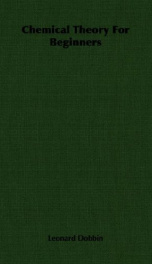chemical theory for beginners

Text extracted from opening pages of book: CHEMICAL THEORY FOR BEGINNERS ATOMIC WEIGHTS OF THE ELEMENTS. CHEMICAL THEORY FOR BEGINNERS LEONARD DOBBIN, PH. AND JAMES WALKER, LL. D., F. R. S. PROFEbSOK OK CHEMISTRY Itf THE UNIVEKblTY OF EDINBURGv MACMILLAN AND . CO;, LIMITED STf MARTIN'S STREW; L'OflbON 191 i MACMILLAN AND CO., LIMITF. U LONDON BOMBAY CALCUTTA MELBOURNE THE MACMILLAN COMPANY NEW YORK BOSTON CHICAGO ATLANTA SAN FRANCISCO THE MACMILLAN CO. OF CANADA, I/ rn. TORONTO First Edition printed 1892 Reprinted 1894, 1896, 1900, 1904, 1906, 1908, 1911 PREFACE OUR object in writing this little book has been to assist beginners in obtaining an elementary knowledge of the principles upon which modern chemistry is based. The smaller text-books which deal with Systematic Chemistry usually treat theoretical matters so lightly that t e student seldom obtains any satisfactory grasp of these during the earlier portion of his studies ; while in the larger treatises the same subjects not infrequently receive similar scant attention, because the student is supposed to have been introduced to them already. For example, beginners are seldom made to understand the full significance of chemical formula?, although they are usually taught to use them at a very early stage in their studies. These chemical formula are the outcome and embodiment of many facts and theories, and their logical introduction into a course of chemistry can only take place at a comparatively late period. Their convenience, however, is felt to be so great, that the student is usually brought face to face with them prematurely, at a time . when he can neither understand their origin nor appreciate their import ; and later, when he begins his more advanced studies, he is often assumed to be quite conversant with them. VI PREFACE In the first part of the book we have endeavoured to remedy this defect, by setting forth in a simple and connected manner, the nature of the facts ( and of the theories derived from them) with which the chemist must be acquainted before he is justified in employing chemical formulae at all. The later chapters contain, amongst other things, an entirely non-mathematical exposition of the more im portant principles of General Chemistry, which has made such great progress of late years, especially in the departments of solution and electrolysis. Although the new theories in this branch of the subject are still received with reserve by many British chemists, we have not hesitated to place them before the beginner, convinced as we are of their usefulness, and of their eventual general recognition. Many of the subjects dealt with have been intention ally, and indeed necessarily, very shortly treated. We hope, however, that enough has been said respecting the most important matters to make the book serve as an easy and yet sufficieii introduction to the larger text books, both of Systematic and of General Chemistry. L. I). J. W. EDINBURGH, June 1892. CONTENTS CHAPTER 1' Al. K INTRODUCTION. ON UNITS AND MEASUREMENT . I 1. SOLIDS LIQUIDS GASES . 5 2. ELEMENTS AND COMPOUNDS . 11 3. CHEMICAL ACTION GENERAL CONDITIONS . . 16 4. CHEMICAL ACTION CHARACTERISTICS ... 26 5. LAWS OF CHEMICAL COMBINATION 39 6. ILLUSTRATIONS OF CHEMICAL ACTION COMBUS TION Irt . . . .50 7. ILLUSTRATIONS OF CHEMICAL ACTION OXIDATION AND REDUCTION 60 8. LAWS OF BOYLE AND OF CHARLES ... 72 9. DENSITY VAPOUR DENSITY . .81 10. AVOGADRO'S LAW 88 11. DETERMINATION OF ATOMIC WEIGHTS ... 94 12. CHEMICAL NOTATION SYMBOLS, FORMUL/ E, AND EQUATIONS 107 vill CONTENTS CHAPTER PAGE 13. BASES ACIDS % ALTS 121 14. THE KINETIC MOLECULAR THEORY . . 139 15. MASS ACTION AND DISSOCIATION . , . .147 1 6. SOLUTIONS . 160 17. ELECTROLYSIS . .176 18. EQUIVALENCE 187 19. SUBSTITUTION AND DOUBLE DECOMPOSITION . 198 20. CHEMICAL CONSTITUTION . . 208 21. THE PERIODIC LAW . ... 221 INDEX . . . 237 INTRODUCTION ON UNITS AND MEASUREMENT . WHEN we measure anything be it a length, a weight, a time, or any other magnit
Info about the book
Author:
Series:
Unknown
ASIN:
B0006C02W8
Rating:
3/5 (4)Your rating:
0/5
Languge:
English
Users who have this book
Users who want this book
What readers are saying
What do you think? Write your own comment on this book!
write a commentGenre
if you like chemical theory for beginners try:
Other books by this author
Do you want to read a book that interests you? It’s EASY!
Create an account and send a request for reading to other users on the Webpage of the book!


